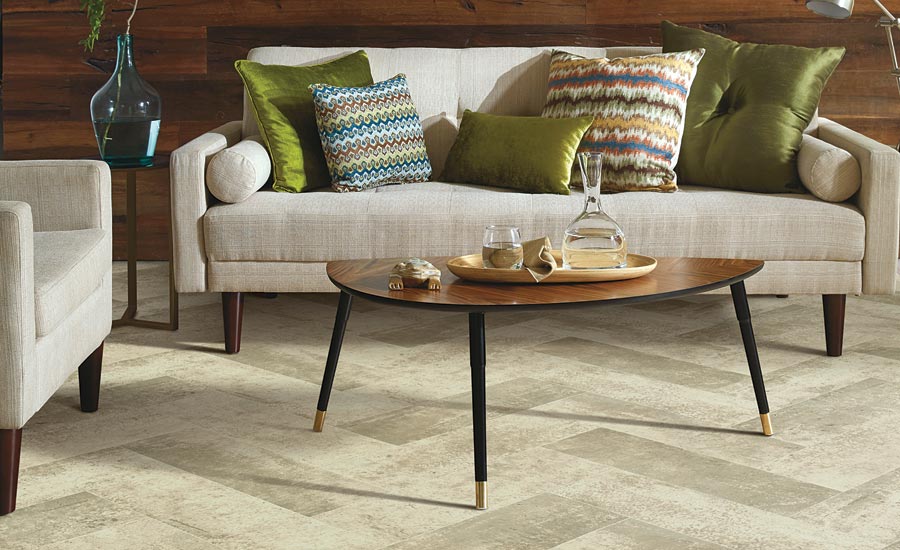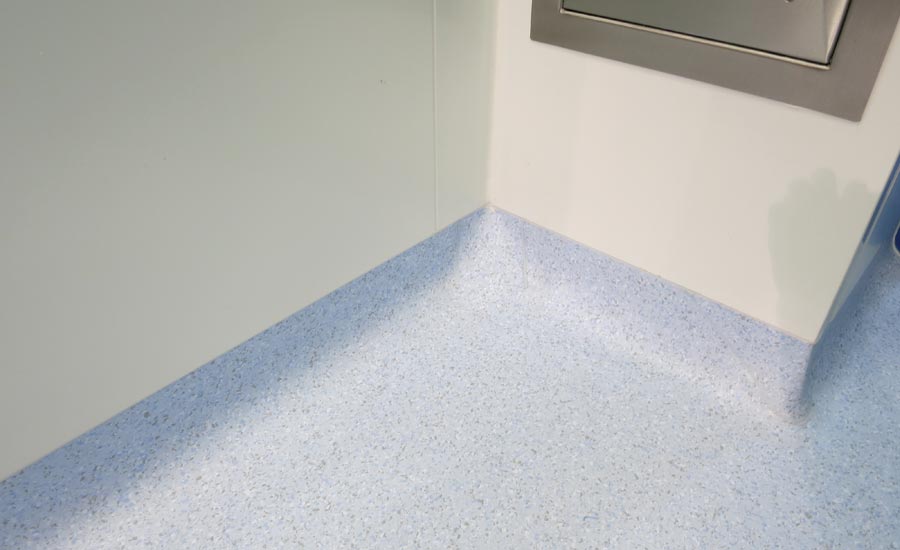Resilient Sheet Flooring Trends

Featured in the patient bays, treatment areas, corridors and nurses’ stations of this medical center is Ecore’s Forest rx, which provides the work environment with a proper level of ergonomic comfort.


Ecore’s Expona Flow is a heterogeneous 2mm thick polyurethane surface that is ideal in heavily trafficked areas, because it’s durable and easy to maintain. This surface’s diverse aesthetics provide facilities with the option of creating a healing environment that’s soothing and home-like or modern and daring.

Gerflor’s Clean Corner System is a patented corner-coving solution that delivers a clean floor at all angles even in the hard-to-reach corners. When installed with Mipolam Wall Panels, it can provide a continuous floor-to-wall solution.

Armstrong’s wide variety of flooring options for healthcare facilities are part of Continuum Solutions, a product portfolio that offers complementary designs and colors across a wide range of commercial flooring solutions.

Armstrong’s commercial flooring products, ColorArt Medintech and Medintone, provide ideal performance, maintenance and installation attributes for healthcare facilities.

Gerflor’s Mipolam Elegance is a high-performance homogeneous sheet flooring with a non-directional, transparent chip design offering the best performance in the industry with the revolutionary Evercare surface treatment, according to the company.







While luxury vinyl tile (LVT) is the rising star in the resilient world, sheet flooring still remains popular as well. Whether vinyl or rubber, vinyl composition tile (VCT) or linoleum, sheet flooring can be found in a range of installations in both residential and commercial settings. We talk with industry experts about the role sheet flooring plays in the marketplace today.
While the LVT category has certainly grown tremendously, in the healthcare market, its growth, although significant, is not as notable, according to Mark Huxta, director of sales, healthcare, Ecore.
“The practical and code requirements for sealed floors in clinical and sterile core areas will always direct the selection to a sheet product. Best practices would suggest that any area that contends with exposure to topical moisture/liquids that may impact the efficacy of that area would also be best served with a sheet product,” he said.
Catherine del Vecchio, marketing director, Gerflor USA, expressed that LVT is growing in popularity and taking market share from almost every flooring category, but especially from flooring that has seams such as carpet and VCT.
“From kitchens to operating rooms, vinyl sheet flooring products continue to offer durable, easy-to-clean, hygienic options in a wide range of looks. As such, sheet flooring remains a popular category.”
“Sheet flooring is used where seams should be avoided, such as healthcare,” she said. “For example, our resilient flooring, Mipolam, used to be our bestselling line, but now LVT and Mipolam have about the same amount of sales; however, they are not cannibalizing each other, as both have seen increased sales in terms of total square feet sold.”
Brian Saker, director of commercial products, Armstrong Flooring, noted that the company’s recent investments in innovation are geared towards the fastest-growing segments in which Armstrong competes, including their Natural Creations luxury flooring.
“As noted on our Q1 2016 earnings call, these investments are yielding strong results with a significant portion of our overall volume growth being driven by LVT, which increased 42%,” Saker said. “We believe that LVT cuts across all markets, including the residential segment. However, our innovation doesn’t stop with LVT.”
Saker continued, “From kitchens to operating rooms, vinyl sheet flooring products continue to offer durable, easy-to-clean, hygienic options in a wide range of looks. As such, sheet flooring remains a popular category. Our continued innovation in sheet vinyl is bringing new designs to market that wow and inspire homeowners, architects, designers and business owners, allowing them to create unique and personalized spaces.”
On another note, Nicki Rayburn, director of public relations and communications, Shaw Floors, argued that the market share for resilient sheet vinyl has remained steady for the past decade. “It’s not on the decline but rather remains relatively flat.”
Keeping Sheet Flooring Hot
When it comes to making sure sheet flooring is still an attractive option, manufacturers are faced with ironing out the details such as identifying the latest and greatest color and design trends.
“The clear and creative graphics that have helped drive the LVT growth are now provided in resilient sheet products,” explained Huxta. “Heterogeneous sheet products are available with high resolution patterns ranging from wood and wood influenced visuals, concrete, linen and abstract and organic patterns. These products enhance the interiors and contribute to the patient or the senior resident experience.”
Del Vecchio found that the best way to differentiate Gerflor’s sheet flooring from LVT is not with design but with technical innovation.
She says, “Gerflor continues to develop technical innovations including evercare surface treatment which is the best finish for chemical and stand resistance, Mipolam Symbioz which is the first resilient sheet flooring with a 100% bio-based plasticizer and Mipolam Dry-Tex, which is made to withstand an RH of up to 98.”
According to del Vecchio, Gerflor manufactures sheet flooring in a comfort backing for comfort under foot and sound management.
Armstrong Flooring’s Homogeneous Sheet flooring provides many different color and visual options, including a simple, organized tonal step system that cross-coordinates with linoleum and vinyl composition tile.
According to Saker, it [Homogeneous Sheet] has a sophisticated, natural appearance with a complete range of colors and neutrals, and also offers a jasped visual in soft colors, along with contrasting chip visuals designed for superior hiding power from dirt and subfloor imperfections.
“Additionally, our Heterogeneous Vinyl Sheet flooring offers designers the subtle beauty and warmth of organic visuals in a versatile resilient floor. Exceptional durability comes from the UV-cured urethane coating, and the highly abrasion-resistant surface makes this heterogeneous vinyl sheet ideal in areas with high traffic and heavy static loads.”
ColorArt Medintech and Medintone, along with designer-focused options like DecorArt Rejuvenations, which features homespun tweeds, and pearlized and end-cut wood grain visuals, show Armstrong’s dedication to making sheet flooring an attractive option for interior designers and architects, not only from a design-standpoint, but from a product performance and durability standpoint as well, Saker concluded.
Rayburn added, “Shaw Floors ensures our DuraTru resilient sheet vinyl collection emulates the trends occurring in other hard surface categories. Currently, gray shades are popular, as are wider width visuals. We offer updated hardwood looks and realistic stone visuals consumers can be proud to have in their homes.”
Let’s Talk Commercial
On the commercial end of the spectrum, we discussed whether or not there are advancements in installation or construction that make sheet flooring a good option.
Huxta stressed that healthcare must be focused on the patient experience and outcomes, and to that end, the definition of “performance” should be revisited.
“Durability, maintainability and roller mobility are all critical and represent the traditional concept of flooring performance. Perhaps it’s time to consider if a floor can do more,” he said. “Can a floor reduce the risk of injury from a patient or resident fall? Can a floor enhance the well-being of dedicated staff members? Can a floor quiet the healing environment? These are the pressing issues that challenge the healthcare provider today.”
There’s no doubt there is a definite cost associated with each issue—costs that are typically unbudgeted and not reimbursable, continued Huxta. “Innovative technology has been developed and used by some of the most prominent healthcare providers for more than two years, technology that addresses these issues and provide optimal solutions that have a positive impact on people—patients, residents and staff,” he said.
Speaking of technology, del Vecchio highlighted the Gerflor Clean Corner System, which is a patented corner-coving solution that she said delivers a clean floor at all angles even in the hard to reach corners. “It is watertight and easy to maintain. When installed with our Mipolam Wall Panels, it can provide a continuous floor to wall solution,” she said.
Homogeneous sheet flooring brings more than uniform colors and textures to commercial environments, added Saker. This proven product category offers interior designers and architects high-performance, low-maintenance and easy-installation flooring solutions for a variety of spaces. Armstrong Flooring offers homogeneous sheet flooring that can be heat welded and flash-coved for spaces demanding superior infection control, increased moisture limits and seaming options allow faster installation which is well suited for procedure rooms, operating rooms and laboratories, according to Saker.
Sheet Flooring Proves Beneficial
Since sheet flooring (such as rubber) is well-suited for hospital and healthcare environments, we touched upon some of the benefits of these types of surfaces and why they are still being specified to stand up to tough commercial traffic.
“Sheet flooring is still very relevant and needed within the healthcare environment,” explained del Vecchio. “Mipolam by Gerflor has exceptional stain resistance qualities, is certified ISO 22196 to resist the spread of bacteria, has fewer seams than other flooring options and as a homogeneous product, this no wax floor has a life cycle that is twice as long and is easy to maintain.”
According to Saker, Armstrong’s commercial flooring products, ColorArt Medintech and Medintone, provide ideal performance, maintenance and installation attributes for healthcare facilities including Homogeneous construction offering essential infection control, easy maintenance reducing labor costs while enhancing operational efficiency and increased moisture limits and seaming options allowing for faster installation.
“Smart flooring choices not only have the potential to maximize efficiencies through faster installation and easy maintenance; they can also improve patient satisfaction through noise reduction, a clean appearance and colors and patterns that support a healing environment,” Saker added.
While Armstrong’s flooring products are designed for these needs and include a variety of long-lasting, low-maintenance options, they also reflect the requirements of interior designers, architects and healthcare facility managers.
“Our wide variety of flooring options for healthcare facilities are part of Continuum Solutions, a product portfolio that offers complementary designs and colors across a wide range of commercial flooring solutions,” explained Saker.
The healthcare industry is dealing with a dynamic shift that challenges the financial sustainability of the providers at a time when the Patient First focus has never been more important, said Huxta.
“With reimbursements tied to performance and outcomes, as well as the patient experience as measured by Hospital Consumer Assessment of Healthcare Providers and Systems (HCAHPS) scores, we should redefine our expectations for flooring,” said Huxta. “We should expect more from a floor. The industry has done a wonderful job of reducing the number of falls, but patient and resident falls still happen.”
Huxta reminds us, “The aging nurse population working longer hours and experiencing pain, discomfort and fatigue as a result of working on hard floors, along with the patients telling us the healing environment is not a quiet environment at a time when we know a quiet environment impacts healing and quality of life. This is the time to reset the bar for what a floor can do for the provider, the patient and the resident. When a floor can have a positive impact on people, we are all better off for it.”
Looking for a reprint of this article?
From high-res PDFs to custom plaques, order your copy today!
















